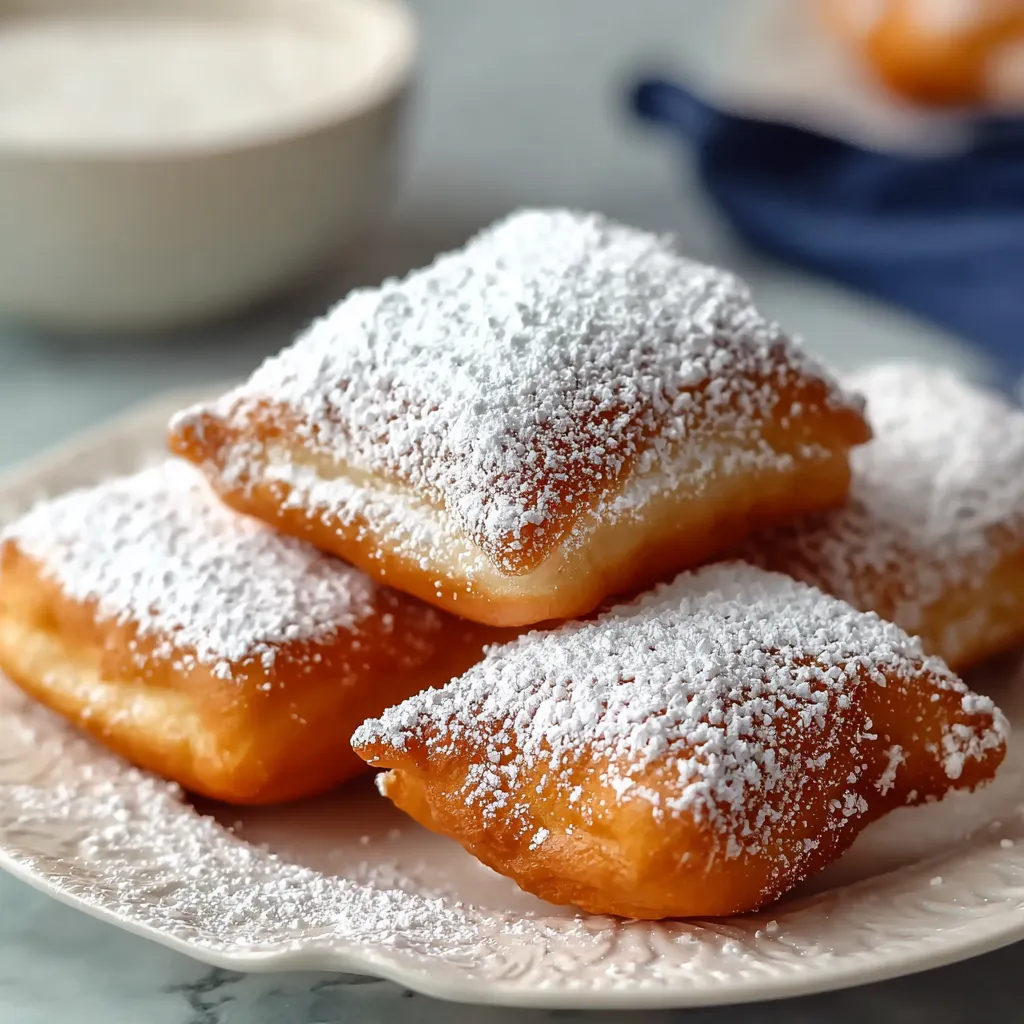 Save it
Save it
Vanilla French beignets are the kind of treat that turn an ordinary morning or rainy afternoon into something joyful. Fluffy and golden, full of warm vanilla fragrance and finished beneath a snowy drift of powdered sugar, these classic beignets never last long at my kitchen table. Their simple dough comes together with pantry basics, and the fry transforms them into pillows that practically melt in your mouth.
I first made these beignets to surprise my mother on her birthday. Now making them together is a tradition we look forward to, especially while the coffee brews and morning sunlight pours in the window.
Ingredients
- Active dry yeast: For that perfect pillowy rise. I like to check it is fresh by making sure it bubbles in warm water before using.
- Warm water: As the base for activating the yeast. Filtered water at about body temperature works best.
- Granulated sugar: For lightly sweetening and helping the dough brown as it fries. Use pure cane sugar if you can.
- Large eggs: To add richness and structure. Room temperature eggs will blend best.
- Whole milk: Brings extra tenderness. Fresh milk is my go to but any milk with a good fat content will work
- Unsalted butter: For a subtle buttery note and tender texture. Melt fully before adding to the mixture.
- Vanilla extract: Really shines here. Choose real vanilla extract for the fullest flavor.
- All purpose flour: Forms the dough. I like King Arthur or another high quality unbleached flour
- Salt: Essential for balancing all the sweet flavors. Just a pinch goes a long way.
- Oil for frying: Gives that signature golden crust. A neutral oil with a high smoke point like canola or peanut keeps flavors true.
- Powdered sugar: For the final snowy touch. Sift before dusting for a delicate finish.
Step-by-Step Instructions
- Activate the Yeast:
- Combine the active dry yeast with warm water and a small pinch of sugar in a small bowl. Let this sit for at least five minutes. Look for a foamy surface which means your yeast is alive and ready to work.
- Mix the Wet Ingredients:
- In a large mixing bowl, whisk together the granulated sugar, eggs, whole milk, melted unsalted butter, and vanilla extract until everything is completely smooth and combined. Mixing well ensures a uniform dough texture later.
- Make the Dough:
- Gently stir in the activated yeast mixture to the wet ingredients. Gradually add in the all purpose flour and just a pinch of salt, stirring as you go to avoid lumps. Once a rough dough forms, switch to your hands and knead for several minutes until the dough becomes smooth but still a little tacky.
- First Rise:
- Place the dough in a lightly greased bowl and cover with a clean kitchen towel. Set this in a warm spot with no drafts—inside an unheated oven or near a sunny window works nicely. Let the dough rise for one to two hours until it doubles in size. Patience here makes all the difference in texture.
- Shape the Beignets:
- Turn the risen dough out onto a lightly floured surface. Gently roll it to about half inch thickness, making sure not to press out all those precious air bubbles. Use a sharp knife or biscuit cutter to cut the dough into your desired shape, either squares or circles.
- Fry to Perfection:
- Pour enough oil into a deep fryer or large pot to submerge the beignets. Heat the oil to three hundred fifty degrees Fahrenheit, checking with a thermometer for accuracy. Fry the shaped dough in batches, flipping after about two to three minutes per side, until each is deeply golden and puffed.
- Drain and Dust:
- Remove finished beignets from the oil using a slotted spoon, letting excess oil drip off. Set them on a plate lined with paper towels to drain further. While still warm, sift a generous layer of powdered sugar over each one. Serve immediately for the best texture.
 Save it
Save it
Vanilla is my secret star in this recipe. A few years ago, my cousin brought back a little bottle from a trip overseas and its flavor transformed every batch. I love how the aroma drifts through the house reminding everyone that something delicious is coming soon.
Storage Tips
Store leftover beignets in an airtight container at room temperature for up to two days. If you want to keep them longer, freezing is your best bet. Simply lay cooled beignets in a single layer on a baking sheet, freeze until solid, then transfer to a zip top bag for up to three months. Rewarm for a few minutes in a low oven to restore their softness and warmth before serving.
Ingredient Substitutions
If you do not have whole milk, use two percent or even a mix of milk and half and half for richness. Dairy free milk alternatives work in a pinch but the dough might be a bit less tender. Swap vanilla bean paste for extra strong vanilla flavor or almond extract for a unique twist. If you do not have an egg, a flaxseed egg provides some binding but the texture will be a bit different. For frying, use any neutral oil you trust for high heat cooking.
Serving Suggestions
Pile beignets on a platter and dust with extra powdered sugar just before bringing to the table for wow factor. I love to serve these with a side of homemade berry jam or citrus curd for dipping. They also pair beautifully with coffee or strong tea for a French inspired café feel at home. If you want to go classic, enjoy them while still warm with steaming café au lait.
Cultural Context
French beignets have deep roots in the country’s patisserie tradition, brought to Louisiana by French settlers and cherished in places like New Orleans for generations. The word itself simply means fritter and these treats symbolize celebration and comfort wherever they are enjoyed. Every culture seems to have its own take on the fried dough pastry, but there is something about the vanilla and snowy sugar that feels uniquely French and festive.
 Save it
Save it
Let these beignets bring a moment of simple joy to your kitchen like they do in mine. Every time I make them, I remember flour dusted hands and laughter around the breakfast table. There is no need for a special occasion, the aroma of fresh vanilla beignets is all the celebration you need.
Common Questions
- → What type of yeast is best for these beignets?
Active dry yeast works well, giving the dough a light and airy texture after rising. Make sure it's fresh for best results.
- → Is it necessary to use whole milk?
Whole milk adds richness, but you can substitute with 2% or even a non-dairy alternative, though texture may vary slightly.
- → How thick should I roll out the dough?
Roll the dough to about ½-inch thick to achieve a fluffy interior once fried.
- → What is the best oil for frying?
Neutral oils with high smoke points, such as canola or vegetable oil, are ideal for deep frying beignets.
- → How can I ensure my beignets are not greasy?
Drain fried beignets on paper towels and make sure your oil is at the proper temperature—around 350°F—for crisp, non-greasy results.
- → Can I prepare the dough ahead of time?
Yes, the dough can be prepared a day ahead and refrigerated after the first rise. Let it come to room temperature before rolling and frying.
